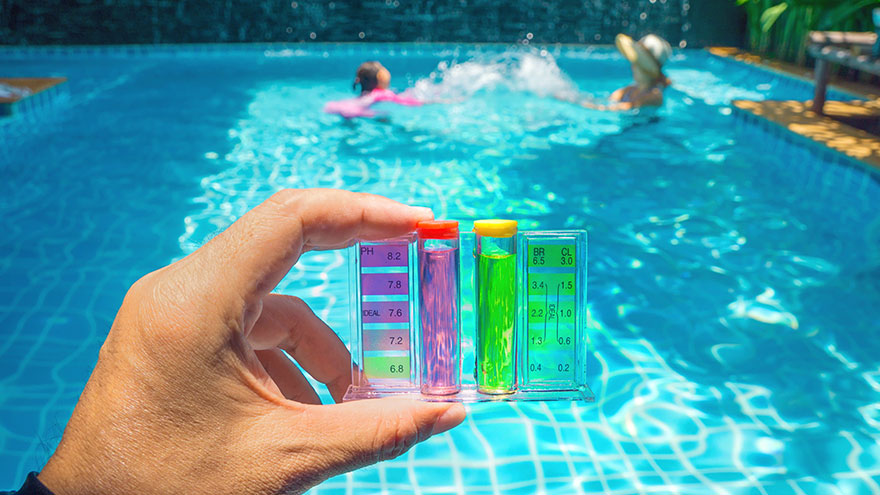Dangerously High Levels of Chlorine in a Pool
Swimming pool owners that choose to use chlorine as their pool water disinfectant should always treat it with respect. Chlorine is classified as a hazardous material, though it’s safe when handled and stored properly.
Chlorine is a also potent chemical that’s poisonous at relatively low levels. In a swimming pool with excess chlorine, minor issues begin cropping up almost immediately. There’s also a point in a pool when too much chlorine will be dangerous.

Chlorine Levels
For swimming pools, owners shouldn’t allow chlorine levels to rise much past 3 parts per million. The recommend range of chlorine for swimming pools is also only 1 ppm to 3 ppm, with 2 ppm being a good level to maintain.
Once a pool’s chlorine levels exceed 5.5 ppm, swimmers will begin experiencing real issues, including eye, ear, skin and mucus membrane irritation. At 10 ppm of available chlorine, a swimming pool becomes too uncomfortable and possibly dangerous to swim in.
Chlorine Hazards
Chlorine is classified as hazardous for good reason, and when it’s in its natural gaseous state, it is highly dangerous. Fortunately, it takes an extremely high level of chlorine in a swimming pool to create an atmospheric hazard from the release of gas.
Long before such a chlorine level is reached in a pool, the smell of the chlorine would provide a hazard warning. At 25 ppm, during chlorine shocking or superchlorination, outdoor pools are dangerous for swimming but present little inhalation hazard.
Dangerous Levels
Superchlorination of a swimming pool is an effective and regularly applied disinfection method. Superchlorinating a swimming pool involves raising chlorine levels to anywhere from 10 ppm to more than 25 ppm.
While no pool should be used for swimming when chlorine levels are at 10 ppm or more, the risk is related to direct swimming contact, not breathing. However, indoor pools are more susceptible to danger because of their enclosed nature, with strong chlorine fumes possible when superchlorination occurs.
Considerations
When looking at high chlorine levels in a swimming pool separate the dangers from excess chlorine into swimming versus inhalation. Outdoor pools with chlorine levels much higher than will ever be deliberately created pose little inhalation risk.
Indoor pools should be carefully monitored for chlorine fumes, though, because of their warm, humid atmospheres. In all instances of chlorination, however, if pool chlorine odors become overpowering, you must immediately evacuate the pool vicinity and inform emergency authorities.
Chlorine Reactivity
It’s important to understand that chlorine is a halogen and is highly reactive. For example, chlorine combined with another chemical, like ammonia, can negatively and even violently react. Also, one type of chlorine may be higher in chlorine concentration than another type of chlorine.
For instance, calcium hypochlorite averages about 65 percent chlorine by volume, while sodium hypochlorite is only about 12 percent. Before adding chlorine to a pool, know its chlorine concentration and follow dosing instructions to the letter.
You Might Also Like :: What Are the Dangers of Chlorine in Heated Swimming Pools?

